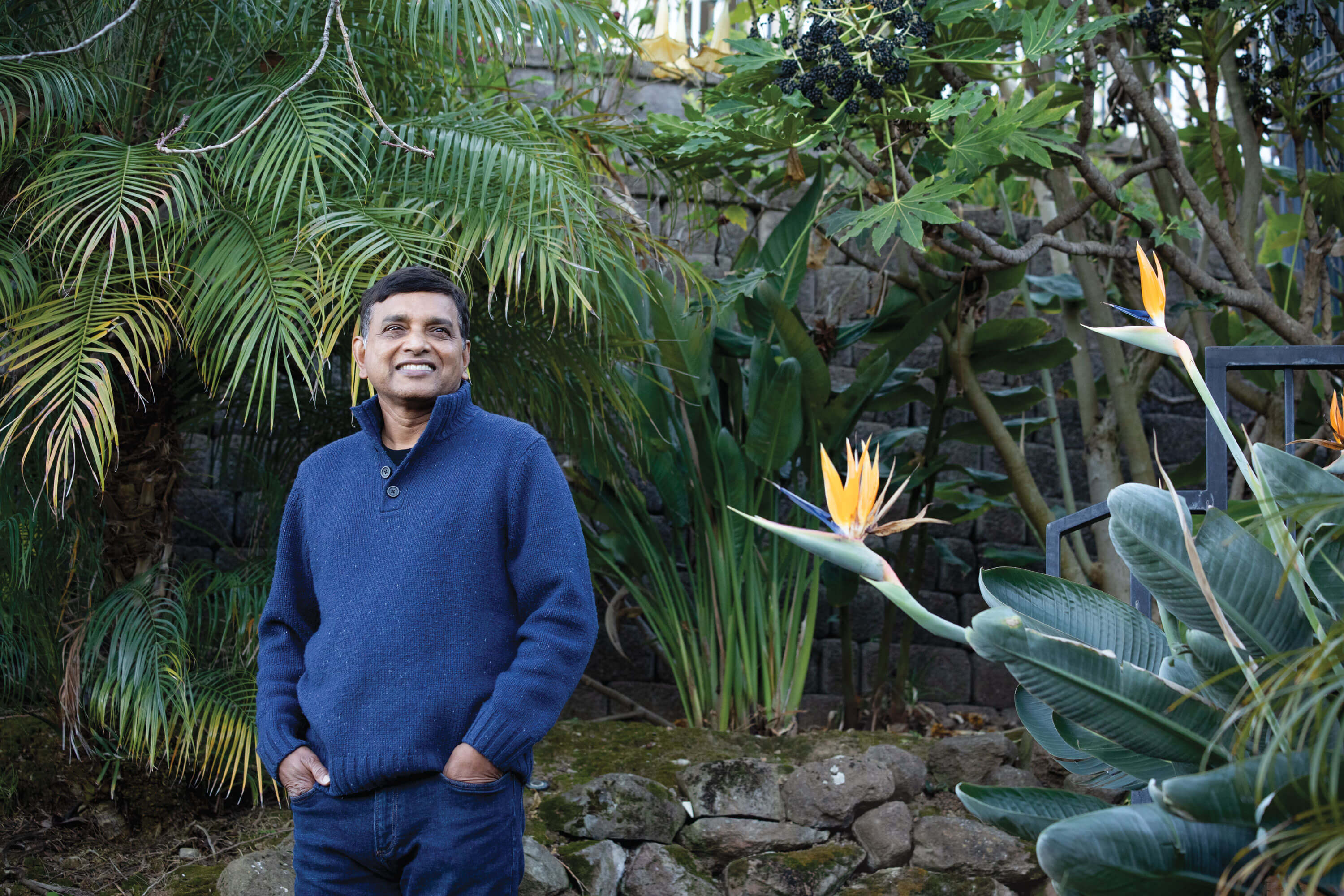
Ahead of the Curve
Entrepreneur Krish Ramakrishnan has made a career of being in the right place at the right time.
On a Thursday night in March 2020, while waiting for a flight in a Chicago airport, BlueJeans co-founder Krish Ramakrishnan ’83M, ’19HN got an urgent call from one of his company’s biggest customers, Facebook. With cases of COVID-19 cropping up globally and cities mulling stay-at-home orders, the social media giant was going to shut down its global offices and have its employees work remotely—and lean heavily on BlueJeans’ video conferencing platform. “You’re going to be the mission-critical connection for us,” they told Ramakrishnan. “Are you ready?”
Facebook was the first domino. The next day, another Fortune 500 company called with the same message. Soon after, a large, top-ranked public research university in the Midwest called to let him know that they would be transitioning to remote learning. Over the next four days, traffic on BlueJeans’ networks shot up by 250%.
While the pandemic’s instant demand spike was impossible to predict, Ramakrishnan had been seeing the trend lines lead here for decades. With increasingly globalized workforces, companies would need a better way to connect with employees working remotely and expand their talent pool—and video, he believed, would be the communication medium that could make that happen.
Ramakrishnan’s ability to identify these kinds of movements in their nascent stages is a big part of what has made him a successful serial entrepreneur, having built and sold two tech companies before BlueJeans. “If you want to start a company, you need to look at technology and project it two to three years out,” he says. “You want to create a company that solves tomorrow’s problem, not today’s problem.”

Self-funded and lacking any name recognition, the startup still managed to get the attention of Silicon Valley tech giant Cisco Systems, which eventually offered to buy the company. The final negotiations were a remarkable scene. Ramakrishnan was called in to meet with John Chambers, Cisco’s legendary CEO, who told him he wanted to buy the company on the condition that Ramakrishnan work there for four years afterward. There would be a contract, Chambers said, but what guarantee could the founder really give him that he would stick around? “You’re right,” Ramakrishnan told him. “No contract is going to force anybody to stay if they don’t want to stay.” He extended his hand. All he had was his word: “I don’t need a contract. You just need to trust me.” Chambers took his hand, and the deal was done.
After five years at Cisco, Ramakrishnan tried retirement for three months. It didn’t take. “Staying at home, learning golf—it wasn’t working,” he says. In 2001, he became CEO of Topspin Communications, whose tech helped string clusters of servers together. Or at least, that was the company’s eventual offering.
When Ramakrishnan arrived, Topspin was in disarray. The market for its main product had collapsed, he soon realized, and he had no ready fix. “So we either had to return our investors’ money,” which was about $14 million of the $15 million it had raised, “or we had to find something different to do.” He divided the company into three teams, each tasked with devising a new idea in 30 days. “All of the ideas were bad,” he says with a laugh, “but one idea was slightly better than everything else.” The new tech found a market, took off, and—once again—caught the attention of Cisco. In 2005, they acquired Topspin for $250 million.
After another stint at Cisco, he spent a few years at Silicon Valley venture firm Norwest Venture Partners, where he met his BlueJeans cofounder, Alagu Periyannan. Ramakrishnan had a vague interest in doing something in the video space; Periyannan had relevant experience, including working at Apple on the company’s QuickTime video application. They hit it off over an initial coffee and spent the next several months developing what would become BlueJeans—a simpler, more user-friendly videoconferencing system. (The name BlueJeans is meant to connote its strength and ease of use. Ramakrishnan came up with it while driving to a pitch meeting with venture capitalists, listening to Neil Diamond’s “Forever in Blue Jeans.”)
Again, it would be Ramakrishnan’s job to run the company. He attributes his fit in this role to “a disability of mine.” “I can’t dive that deep into a subject, but I can see the forest from the trees. I can see the pattern,” he says. “My cofounder, Alagu, is a very rigorous engineering talent—very bright, very articulate. I could only paint a picture, but he had the wherewithal to construct it.”
Periyannan says those pictures are important, of course. “My ideas were very broad and focused on how to solve a problem,” he says. “And Krish had a really nice way of taking that and creating a story out of it.”
Periyannan also heralds his cofounder’s steadiness: “With any sort of entrepreneurial journey, it’s got many ups and downs. Lots of these can actually pull apart a founding team. That never happened with us—we’ve always had that trust, but also a fair amount of empathy for each other.”
Navigating the downs can be emotionally taxing, though. Periyannan offers an example from a few years ago, when BlueJeans’ growth stalled a bit and the pair decided it was best to bring on an outside CEO and have Ramakrishnan move into an executive chairman role. “That was not easy,” says Periyannan. Humility can be a rare trait in Silicon Valley, but it’s another reason why Ramakrishnan has thrived, he says. “One of the things that Krish has taught me is that when you start a company, it’s about the investors, the shareholders, the employees, the customers—you know, all of the stakeholders. It’s not just about the two founders and what we wanted.” It’s about doing the right thing, he says, even if it’s the hard thing.
~
In mid-April 2020, BlueJeans announced that it was being acquired by Verizon. In the midst of an unprecedented surge that tested its mettle, the company was now also in the process of managing its sale, with the cofounders ping-ponging between war room calls to address the booming traffic and huddles about the upcoming acquisition.
The move offered the company an instant influx of cash and the stability of a Fortune 500 company in Verizon, says Ramakrishnan. And as he did when he sold his previous companies to Cisco, he has stayed on to help with the transition. “I need to feel that this acquisition has been successful for Verizon,” he says.
But there won’t be a victory lap. “My success has really been about being fortunate and being lucky more so than being smart,” he says. Turning a canceled class into a master’s degree at Monmouth, chasing a dream in Silicon Valley, hoping a handshake would make a viable replacement for a contract— these are all moments where Ramakrishnan could easily have failed. And while some might naturally attribute Ramakrishnan’s success to perseverance, honesty, integrity, gumption, or guile, he prefers to attribute it to simple good fortune.